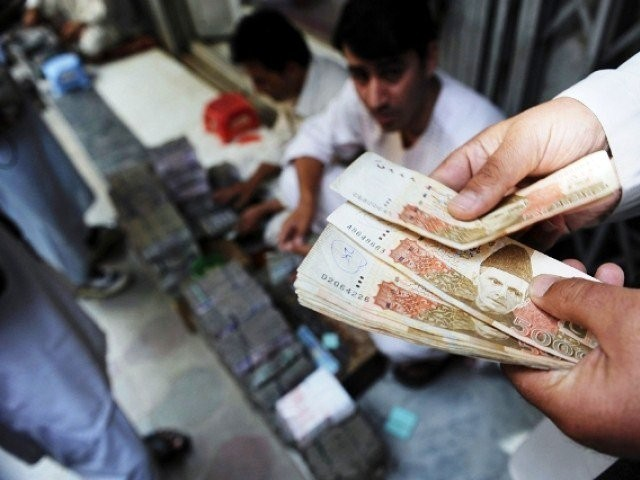Pakistan’s budget deficit soars to record Rs1.48 trillion
Surpasses annual target in just nine months, sparks questions over promise of fiscal discipline

PHOTO: EXPRESS
The overall budget deficit - the gap between income and expenditure - widened to 4.3% of gross domestic product (GDP) or Rs1.481 trillion in Jul-Mar 2017-18, according to the Ministry of Finance that released a consolidated summary of federal and provincial budgetary operations on Monday.
In absolute terms, it was the highest-ever budget deficit that Pakistan recorded for Jul-Mar in any fiscal year. In terms of total size of national economy, the 4.3% deficit was the highest in five years and even higher than the 4.1% annual target that former finance minister Ishaq Dar had set in June last year.
Pakistan’s budget deficit widens to Rs796.3b
It seemed that the Ministry of Finance did not exercise control over expenses and kept sanctioning expenditure requests without having the fiscal framework in mind. One reason for such a lax control was the posting of inexperienced bureaucrats in the ministry.
The Rs1.481-trillion budget deficit came despite the fact that four provinces of the country showed a cash surplus of Rs174 billion in the first nine months. Excluding provincial savings, the federal budget deficit would have jumped to Rs1.65 trillion.
Balance of payments: Evolution of policymaking to control budget deficit
Earlier, the Pakistan Peoples Party-led government had booked a 4.4% budget deficit in Jul-Mar of fiscal year 2012-13, which was its last year in power. In absolute terms, the 4.4% deficit was equal to Rs1.04 trillion.
The latest figures negate the federal government’s claim that it has reversed the trend of last fiscal year when the budget deficit peaked to a historic high of Rs1.863 trillion or 5.8% of GDP.
The Rs1.481-trillion deficit suggests that even the revised annual target of 5.5% of GDP or Rs1.891 trillion will be breached.
Ratings agency Moody’s Investor Services on Friday listed “material widening of fiscal deficit” among the triggers that could lead to downgrading of Pakistan’s credit rating.
Defence, debt to eat up half of proposed Rs5.237 trillion budget for 2018-19
Other elements that could cause a downgrade are stalling of the IMF programme’s economic reform agenda, worsening of external payments’ position, loss of multilateral/bilateral support or renewed political instability, according to Moody’s.
“The government’s very narrow revenue base restricts fiscal flexibility and weighs on debt affordability,” Moody’s said in its May 18th report on Pakistan.
The budget and current account deficits remain the two biggest challenges for Pakistan’s economy that overshadow the government’s economic performance in other areas. Because of the twin deficits, there are apprehensions that Pakistan may go back to the IMF for another bailout.
It seems the government has opened the purse for spending just before elections. Most of the development spending went to the schemes that can benefit the ruling party in upcoming elections.
Another main reason for the record-breaking budget deficit was ballooning debt servicing. From July through March of the current fiscal year, the domestic and foreign debt servicing consumed Rs1.172 trillion, according to the Ministry of Finance. It was 86% of the annual budget estimate.
The government’s growing reliance on short-term domestic and foreign borrowing has significantly increased the debt servicing cost.
Defence spending in nine months stood at Rs623.8 billion, which was 67.7% of the budget estimate. Both debt servicing and defence expenses consumed 56.4% of total expenditures in first nine months of the current fiscal year.
Overall, the federal government’s expenditure stood at Rs3.2 trillion in the Jul-Mar period, which was roughly two-thirds of the annual budget. However, current expenditures amounted to Rs2.67 trillion, which were more than 70% of the annual allocation.
Federal development spending in the first nine months amounted to roughly Rs416.4 billion or about 41.5% of the annual budget.
Revenue receipts remained at Rs2.8 trillion or 64.5% of the annual estimate. The Federal Board of Revenue’s tax collection was Rs2.627 trillion or 65% of the annual target.
Non-tax revenues stood at only Rs390 billion due to curbs placed by the US on the release of Coalition Support Fund. The State Bank of Pakistan contributed Rs143.2 billion or 55% of its annual targeted profit.
The collection of petroleum levy increased to Rs136.4 billion or 85% of annual projection. It will also remain a main tool to increase federal tax collection in the next fiscal year.
Published in The Express Tribune, May 22nd, 2018.
Like Business on Facebook, follow @TribuneBiz on Twitter to stay informed and join in the conversation.



















COMMENTS
Comments are moderated and generally will be posted if they are on-topic and not abusive.
For more information, please see our Comments FAQ